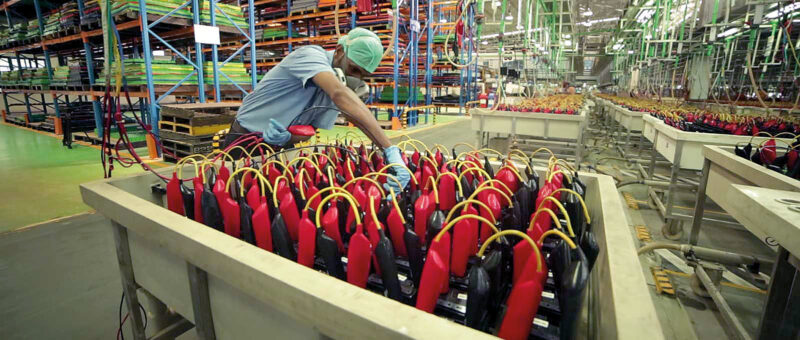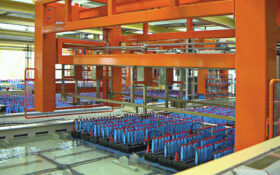As the so-called Delta variant of COVID-19 swept its deathly reach across the globe, the brutal ‘second wave’ of corona dealt a heavy blow to India this summer. But as its people reeled, the country’s battery manufacturing industry quietly went about its business with hardly any effect on business. Dipak Sen Choudhury reports on how those firms stayed resilient during the pandemic.

By now the world is aware of the brutal blow the second wave of coronavirus has dealt to India this summer. This was just at a time when the entire country was about to recover from the wounds of the ‘first wave’ that had already left the economy shattered.
Pictures of Corona patients, in elite cities like Delhi or Mumbai, gasping for breath, waiting indefinitely in front of hospitals since there were not enough beds for all of them to be admitted, had flooded the world media. Even enough oxygen supplies were not available, which would’ve provided some interim relief, and patients were sent back home to carry on a hopeless struggle to live. Up-country the scenes were far worse, with India’s completely inadequate healthcare infrastructure in tier 2 & 3 getting overwhelmed by the sheer number of patients arriving for treatment.
It is not a subject matter of this piece to examine why this had to happen during the second wave when there were a million advance advisories on the inevitability and imminence of its arrival. Suffice it to say India was not prepared, despite all the warnings— neither in terms of ramping up the health care facilities nor in terms of administering the vaccination.
Now with the ‘third wave’ being ominously on its way, as per experts’ warnings, it is a desperate struggle that is going on across the whole country, to vaccinate as many people as possible and build health care facilities, literally in millions, across this vast country.
First wave
Looking back at the ‘first wave’ and its impact on the economics of the country it is curious to find the energy storage industry did not do too badly. I was reading the annual report of a battery manufacturing major in the country where it was quietly claimed that the pandemic has hardly affected the business of the company. The numbers stated in the financial documents confirm the same.

Remember Q1 of the fiscal year 2020/21 was a washout, particularly the first two months: April and May 2020— there being a near-total lockdown in the country. Yet the two battery majors in the country— Amara Raja Batteries and Exide Industries Limited— have been able to achieve a small but significant growth in their top lines, although at a slightly smaller bottom line, for the entire fiscal year. This is very creditable and showed the resilience of the two organisations and their capability to rejig their business strategies quickly to adapt to any emerging situation.
The story is a little different for the medium-sized manufacturers who, unlike the majors, suffered relatively more due to their focus on a limited number of application segments, and having limited financial reserves.
The three segments on which these medium-sized companies focus are UPS, home inverters and replacement SLI, including the two-wheelers market.
The UPS industry was sluggish, and started to pick up pace only after half of the year was gone; thereafter picked up quite an awesome pace, given the entire country was largely shifting towards work-from-home culture.
In fact, the UPS manufacturers did excellent business in the second half of 2020–21, as demands for systems rose towards the later part of the year; this is where the battery majors had significant advantages in capturing the market, well ahead of the smaller ones.
The quick ramp-up of manufacturing capacities, along with a very well-developed, digitised distribution system, helped them capture a larger market share at the expense of the medium and small manufacturers. The increasing lead price also put the cash-strapped smaller entrepreneurs at a disadvantage in this unequal competition with the big two.
Nevertheless, the medium-scale manufacturers— due to the huge demand that was there in the second half of the year— did do reasonable business and could at least recover part of the losses they incurred during the first half of the year.

The home lighting UPS market, more commonly called the inverter battery, is a huge business segment of every manufacturer— whether big, medium or small— and the season coincides with the Indian summer, mostly between March and June, tapering off from July, once the monsoon arrives.
Last year, there was a near-total lockdown for the two full months of April and May. With most manufacturing and commercial setups under lockdown, the shortage of grid power— the main reason for which the inverter battery is an essential item in any Indian household as well as in the SOHO segment— was less too. By the time the country had opened in June, only the tail-end of the business season was available, therefore badly affecting the business cycle on which many small and medium manufacturers depend. An important point here is: in India, all educational institutions have remained shut since April 2020, with no immediate hope of them reopening. The entire education during these last 15 months has been online and it looks like it is here to stay.
This in turn has been a major driver of increasing demand for home inverters, as well as batteries, that has been witnessed since last year, and therefore has been good for the industry, particularly for those in the medium scale of operation.
Depressed OEM sales
Work-from-home is the way India has been working, and with education almost entirely going online ever since Corona made its appearance, data and data transmission have been the hottest commodity being traded. Fortunately, the Indian telecom companies were reasonably well prepared for this and could cope with the huge demand.
However, the reach of these companies had to improve further to cover the rural locations better and all this meant good business in this battery segment. Indian homes had to go in for online shopping for their daily essentials and this in turn promoted retail in a big way. There is a lot of interest now in Indian retail marketing and big global brands (Walmart and others) are all jostling for space.
On a long-term basis though, there is another story which is unfolding. This is the country’s aspirational project of kick-starting the manufacture of ‘Alternate Chemistry Cells’ by providing government vision, regulatory push, tax incentives, and environmental legislation.

By 2027/28 the country aspires to build up 50GWh of energy storage capacity, and this is the first phase only. The authorities are now in the process of shifting gears to add momentum to the setting up of our own gigafactories. This is to be seen against a backdrop of COVID-19 being a major spoiler in this country’s e-vehicle business.
Overall, the energy storage business, largely lead-acid, did quite well during the pandemic time and there is no reason but to be optimistic about the near-term future of this industry.
Alternate battery chemistries
This in turn has been good for the country’s motive power battery business and this is one segment that has shown good growth in the pandemic year too.
Coming to this other segment, automotive OEM sales remained depressed. Passenger cars, commercial vehicles, three-wheelers and two-wheelers all witnessed a sharp drop in sales compared to the previous financial year. The utility-vehicle segment was the only exception with a modest growth of around 12% over the previous year. After-market sales, however, remained healthy and were the mainstay of all battery manufacturers.
Sales of e-vehicles, 2W & 3W largely, in 2020/21 crashed by more than 70% as compared to the preceding year 2019/20.
The current second-wave too has already upset the plan of most e-vehicle manufacturers and if this country sees a severe ‘third wave’ then the entire e-plan may go for a toss. More on this in the next issue!












